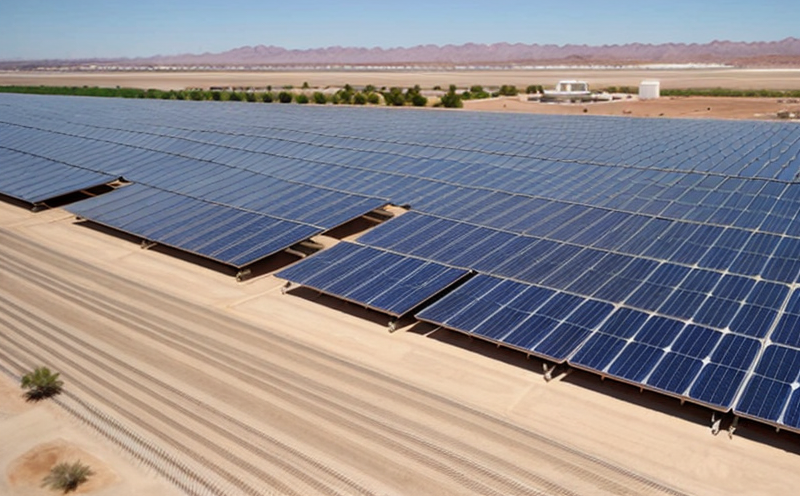IEC 62862-16 Solar Tower Heliostat Field Performance Testing
The IEC 62862-16 standard provides a framework for the performance testing of heliostats in solar tower power plants. This service ensures that the heliostat field meets critical design and operational requirements, contributing to the efficient operation and reliability of Concentrated Solar Power (CSP) systems.
Testing heliostats is crucial because they are key components in CSP systems, responsible for tracking the sun's position and reflecting sunlight onto a central receiver. The performance of these mirrors directly impacts the system’s ability to generate electricity efficiently. This test assesses not only the mechanical integrity but also the optical accuracy of each mirror.
The heliostat field testing under IEC 62862-16 involves several stages, including preparation, calibration, and measurement. The first step is to ensure that all mirrors are correctly installed according to manufacturer specifications. This includes checking for alignment with the sun-tracking system and ensuring there is no structural deformation.
Calibration of each mirror is critical as it ensures they reflect sunlight accurately into the central receiver. Calibration involves adjusting the mirrors so that their reflection points converge at a specified location, typically within millimeters or fractions thereof. This process requires specialized equipment capable of measuring angles and distances with high precision.
The measurement phase assesses the performance of each mirror by evaluating its reflective properties and tracking accuracy over time. Reflective properties are measured using spectral reflectometers to ensure that the mirrors maintain their optical efficiency throughout their operational life. Tracking accuracy is tested by observing how closely each mirror follows the sun's path, which can be quantified through automated tracking systems.
The test also evaluates the heliostat field’s ability to withstand environmental conditions such as wind, temperature changes, and dust accumulation. Environmental stress tests are conducted in controlled environments to simulate real-world scenarios. These tests help identify any weaknesses or potential failures that could affect system performance over time.
Once all parameters have been tested, detailed reports are generated summarizing the findings of each test. These reports serve as a comprehensive documentation of the heliostat field’s performance and compliance with IEC 62862-16 standards. They provide valuable insights into areas where improvements can be made to enhance system efficiency.
Compliance with this standard is essential for CSP systems that need to meet stringent regulatory requirements and ensure high levels of reliability and safety. By adhering to these tests, operators can optimize the performance of their solar tower power plants, leading to lower operational costs and increased energy output.
Eurolab Advantages
At Eurolab, we pride ourselves on offering unparalleled expertise in CSP testing. Our state-of-the-art facilities and experienced staff ensure that your heliostat field receives the highest quality of service:
- We have dedicated laboratories equipped with advanced instruments to perform precise measurements.
- A team of certified engineers specializing in solar technology guarantees accurate assessments.
- Our comprehensive testing services cover all aspects of heliostat performance, from initial installation to ongoing maintenance checks.
Beyond technical excellence, Eurolab also offers unmatched flexibility and responsiveness. We work closely with our clients to tailor our services to meet their specific needs, ensuring that every project is handled efficiently and effectively.
Why Choose This Test
- To ensure compliance with IEC 62862-16 standards, which are internationally recognized as the benchmark for CSP systems.
- To enhance the reliability and efficiency of your solar tower power plant by identifying potential issues early on.
- To improve system performance through detailed analysis and optimization recommendations based on test results.
By choosing this test, you also contribute to environmental sustainability goals. Efficient CSP plants can significantly reduce carbon emissions compared to fossil fuel-based energy sources. Ensuring optimal heliostat performance is a key step towards achieving these objectives.
Competitive Advantage and Market Impact
Compliance with IEC 62862-16 standards offers significant competitive advantages in the global CSP market:
- It demonstrates your commitment to quality and safety, which can enhance your reputation among stakeholders.
- By ensuring reliable operation of your solar tower power plant, you can attract more investors interested in sustainable energy projects.
- The test results can be used as marketing materials highlighting your adherence to international standards, appealing to eco-conscious consumers.
In terms of market impact, adhering to these tests helps drive industry-wide improvements. As more CSP operators adopt similar practices, overall sector performance improves, leading to advancements in technology and operational efficiency across the board.





